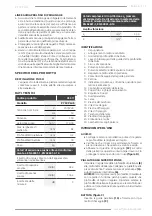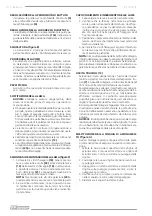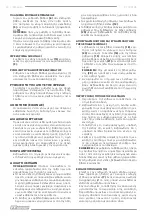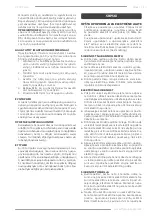
| English
10
P 750 PLUS
have finished work to avoid an incorrect setting when
beginning your next planing task.
REBATING (
image
C)
Attach the parallel guide
(15)
and fasten it using
the locking knob
(9)
.
ADJUSTING THE REBATING DEPTH
Set the rebating depth guide
(3)
to the desired
depth and lock it using the locking lever
(4)
.
ADJUSTING THE REBATING WIDTH
The rebating width is adjusted using the parallel
guide. Loosen the wing nut
(15a)
, set the parallel
guide to the desired position and then tighten the
wing nut again.
CHAMFERING (image E)
The V-grooves on the bottom of the soleplate
makes it possible to chamfer the edges of the
workpiece.
WORK PROCEDURE
In order to achieve a smooth, even surface on the
workpiece it is best to begin with a coarse/deeper cut
and then reduce the cutting depth and finish with a
finer cut. Hold the planer firmly and feed it slowly and
steadily over the workpiece. Switch off and unplug
the planer as soon as you have finished work.
SMALL WORKPIECES
Make sure that small workpieces are firmly clamped
or held in a vice.
CHANGING BLADES
Warning:
Always unplug the mains lead from the
wall socket before any servicing or maintenance.
When the planer blades have been used for a while
they might be too blunt to produce a clean cut and
smooth finish. Continued use of blunt or worn
blades will result in a poor surface finish and could
overload the motor. The blades should therefore
be checked regularly and turned over or replaced
if necessary.
The tungsten carbide tipped blades are dou-
ble-edged and can be turned over and the other
edge used once one of the edges is worn.
The tool for changing or adjusting the blades is kept
in the blade tool holder
(12)
.
The cutting depth of the blade seldom needs to be
adjusted. Do not undo the set screws
(20)
until you
are certain that the cutting depth needs adjusting.
DISASSEMBLING AND ASSEMBLING THE BLADE
(image F)
1.
Undo the three clamping screws
(18)
, hold
down the springloaded guard
(23)
and slide
the blade
(16)
out of the set plate
(19)
. You can
also choose to slide the entire blade holder out
of the blade drum
(21)
and reverse/change the
blade when the blade holder is loose.
NOTE:
Do not move the set screws
(20)
and
pay attention to how the parts are assembled.
2. If the blade holder is removed the parts can
easily disassemble. Make sure that all the parts
are in the right place when the blade holder is
put back.
TURNING THE BLADES OVER/FITTING THE
BLADES
1.
Turn the blade over and fit it into the blade holder.
2.
Make sure that the slot in the blade lines up
with the guides on the drum plate. See the fig
-
ure above. There are also two protrusions on
the drum plate that must line up with two holes
in the set plate. See the figure above.
3. Place the assembled blade holder into the blade
drum. Make sure that the blade holder is in the
centre of the blade drum.
4. Tighten the three clamping screws. Turn the
blade drum by hand to make sure that it can ro
-
tate freely before switching the planer on.
NOTE:
If you adjust the cutting depth, the edge
of the blade must not protrude more than 1.1 mm
from the drum. It is important that both blades have
the same setting. After changing or adjusting the
blades, make sure that all the screws are tight.
CHIP OUTLET (14)
Select desired chip outlet side (left or right) with
chip ejector selector button
(7)
. An extraction
hose (Ø 35 mm), can be attached on either side of
the chip ejector.
If desired, attach the dust bag by sliding the noz-
zle onto the appropriate chip extraction port. For
efficient operation, empty the dust bag when it
is no more than half full, allowing better airflow
through the bag.
You can also connect your tool to a suitable dust ex-
traction system through the extraction port. Hose
adaptors (not included) may be needed depending
on the side of your dust hose.
WARNING:
Shavings may jam in the dust ex-
traction port when cutting damp wood. Clean
out the shavings with a stick, but only when the
cutter has stopped running and the tool has been
unplugged from the power source.
CHANGING THE DRIVE BELT (image G)
WARNING:
Always unplug the mains lead from the
wall socket before any servicing or maintenance.
1.
Undo the two screws holding the drive belt cov
-
er and remove it. Remove the drive belt. Clean
both belt pulleys.
2. Place the new drive belt onto the small pulley.
3.
Work the other end of the drive belt up over
the large pulley while rotating the pulley by
hand.
4.
Make sure that the belt sits properly in the
grooves on the pulley wheels.
5.
Refit the belt cover.
MAINTENANCE
Regular inspection and cleaning reduces the neces
-
sity for maintenance operations and will keep your
tool in good working condition. The motor must be
correctly ventilated during tool operation. For this
reason avoid blocking the air inlets.
Summary of Contents for 43 011
Page 3: ...2 8 4 7 3 11 14 8 4 3 10 9 15 15a P 750 PLUS 3 B C...
Page 4: ...22 E 4 P 750 PLUS D...
Page 5: ...18 21 23 17 16 18 20 19 12 5 P 750 PLUS G F...
Page 20: ...20 P 750 PLUS f f f f f f f f f f f f f f SERVICE f f f II...
Page 22: ...22 P 750 PLUS 8 5 6 0 C 15 9 3 4 15a V 12 20 F 1 18 23 16 19 21 20 2 1 2 3 4 1 1 mm 14 7 35 mm...
Page 38: ...38 P 750 PLUS f f f f f E f F f f f f f f f f f f f f f...
Page 50: ...50 P 750 PLUS...
Page 51: ...www ffgroup tools com...











































